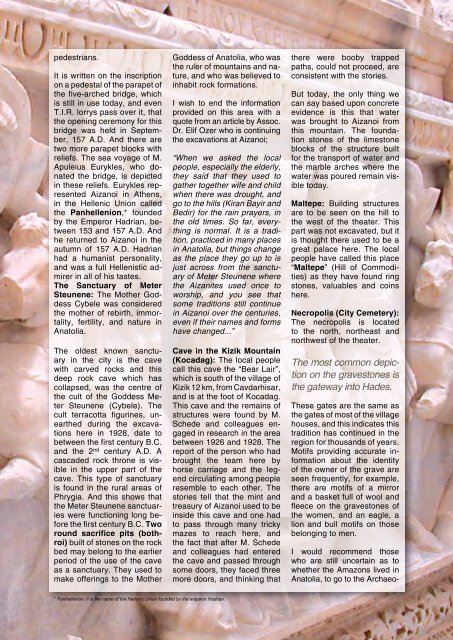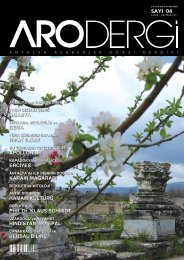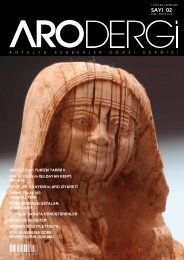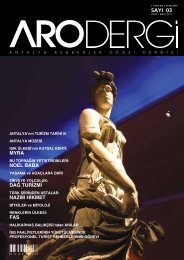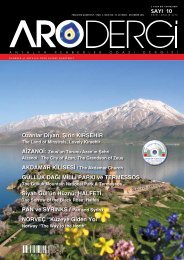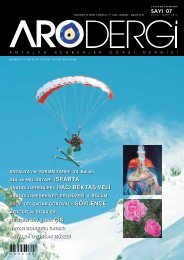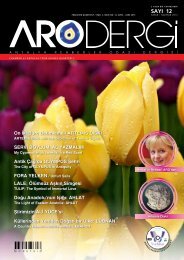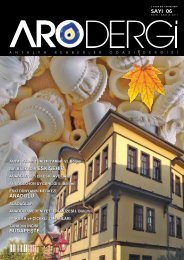Sayı 11- Ocak/Mart 2013 - Antalya Rehberler Odası
Sayı 11- Ocak/Mart 2013 - Antalya Rehberler Odası
Sayı 11- Ocak/Mart 2013 - Antalya Rehberler Odası
- No tags were found...
Create successful ePaper yourself
Turn your PDF publications into a flip-book with our unique Google optimized e-Paper software.
pedestrians.It is written on the inscriptionon a pedestal of the parapet ofthe five-arched bridge, whichis still in use today, and evenT.I.R. lorrys pass over it, thatthe opening ceremony for thisbridge was held in September,157 A.D. And there aretwo more parapet blocks withreliefs. The sea voyage of M.Apuleius Eurykles, who donatedthe bridge, is depictedin these reliefs. Eurykles representedAizanoi in Athens,in the Hellenic Union calledthe Panhellenion,* foundedby the Emperor Hadrian, between153 and 157 A.D. Andhe returned to Aizanoi in theautumn of 157 A.D. Hadrianhad a humanist personality,and was a full Hellenistic admirerin all of his tastes.The Sanctuary of MeterSteunene: The Mother GoddessCybele was consideredthe mother of rebirth, immortality,fertility, and nature inAnatolia.The oldest known sanctuaryin the city is the cavewith carved rocks and thisdeep rock cave which hascollapsed, was the centre ofthe cult of the Goddess MeterSteunene (Cybele). Thecult terracotta figurines, unearthedduring the excavationshere in 1928, date tobetween the first century B.C.and the 2 nd century A.D. Acascaded rock throne is visiblein the upper part of thecave. This type of sanctuaryis found in the rural areas ofPhrygia. And this shows thatthe Meter Steunene sanctuarieswere functioning long beforethe first century B.C. Tworound sacrifice pits (bothroi)built of stones on the rockbed may belong to the earlierperiod of the use of the caveas a sanctuary. They used tomake offerings to the MotherGoddess of Anatolia, who wasthe ruler of mountains and nature,and who was believed toinhabit rock formations.I wish to end the informationprovided on this area with aquote from an article by Assoc.Dr. Elif Ozer who is continuingthe excavations at Aizanoi;“When we asked the localpeople, especially the elderly,they said that they used togather together wife and childwhen there was drought, andgo to the hills (Kiran Bayir andBedir) for the rain prayers, inthe old times. So far, everythingis normal. It is a tradition,practiced in many placesin Anatolia, but things changeas the place they go up to isjust across from the sanctuaryof Meter Steunene wherethe Aizanites used once toworship, and you see thatsome traditions still continuein Aizanoi over the centuries,even if their names and formshave changed...”Cave in the Kizik Mountain(Kocadag): The local peoplecall this cave the “Bear Lair”,which is south of the village ofKizik 12 km, from Cavdarhisar,and is at the foot of Kocadag.This cave and the remains ofstructures were found by M.Schede and colleagues engagedin research in the areabetween 1926 and 1928. Thereport of the person who hadbrought the team here byhorse carriage and the legendcirculating among peopleresemble to each other. Thestories tell that the mint andtreasury of Aizanoi used to beinside this cave and one hadto pass through many trickymazes to reach here, andthe fact that after M. Schedeand colleagues had enteredthe cave and passed throughsome doors, they faced threemore doors, and thinking thatthere were booby trappedpaths, could not proceed, areconsistent with the stories.But today, the only thing wecan say based upon concreteevidence is this that waterwas brought to Aizanoi fromthis mountain. The foundationstones of the limestoneblocks of the structure builtfor the transport of water andthe marble arches where thewater was poured remain visibletoday.Maltepe: Building structuresare to be seen on the hill tothe west of the theater. Thispart was not excavated, but itis thought there used to be agreat palace here. The localpeople have called this place“Maltepe” (Hill of Commodities)as they have found ringstones, valuables and coinshere.Necropolis (City Cemetery):The necropolis is locatedto the north, northeast andnorthwest of the theater.The most common depictionon the gravestones isthe gateway into Hades.These gates are the same asthe gates of most of the villagehouses, and this indicates thistradition has continued in theregion for thousands of years.Motifs providing accurate informationabout the identityof the owner of the grave areseen frequently, for example,there are motifs of a mirrorand a basket full of wool andfleece on the gravestones ofthe women, and an eagle, alion and bull motifs on thosebelonging to men.I would recommend thosewho are still uncertain as towhether the Amazons lived inAnatolia, to go to the Archaeo-* Panhellenion: It is the name of the Hellenic Union founded by the emperor Hadrian.


